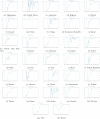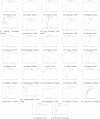Neural network powered COVID-19 spread forecasting model
- PMID: 32834663
- PMCID: PMC7428770
- DOI: 10.1016/j.chaos.2020.110203
Neural network powered COVID-19 spread forecasting model
Abstract
Virus spread prediction is very important to actively plan actions. Viruses are unfortunately not easy to control, since speed and reach of spread depends on many factors from environmental to social ones. In this article we present research results on developing Neural Network model for COVID-19 spread prediction. Our predictor is based on classic approach with deep architecture which learns by using NAdam training model. For the training we have used official data from governmental and open repositories. Results of prediction are done for countries but also regions to provide possibly wide spectrum of values about predicted COVID-19 spread. Results of the proposed model show high accuracy, which in some cases reaches above 99%.
Keywords: 60G25; 68T05; 68T37; COVID-19; Neural network; Prediction.
© 2020 Published by Elsevier Ltd.
Conflict of interest statement
The authors declare that they have no known competing financial interests or personal relationships that could have appeared to influence the work reported in this paper.
Figures











References
-
- Cascella M., Rajnik M., Cuomo A., Dulebohn S.C., Di Napoli R. Statpearls [internet] StatPearls Publishing; 2020. Features, evaluation and treatment coronavirus (COVID-19) - PubMed
-
- Ardabili S.F., Mosavi A., Ghamisi P., Ferdinand F., Varkonyi-Koczy A.R., Reuter U., et al. COVID-19 outbreak prediction with machine learning. Available at SSRN 35801882020;.
LinkOut - more resources
Full Text Sources

